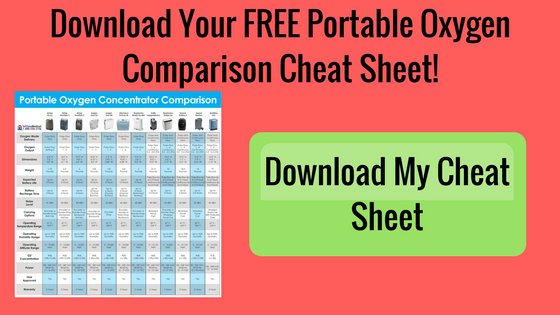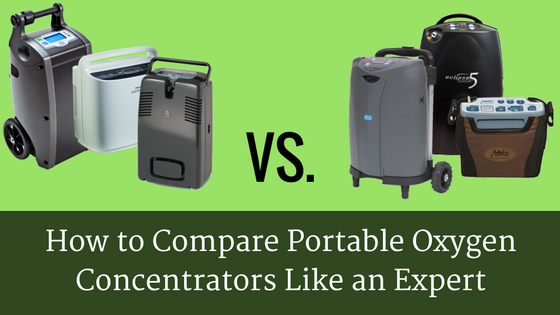
When the time comes for you to purchase a portable oxygen concentrator you will be provided with a number of different models to choose from.
This normally wouldn’t be an issue when you have a store you can physically visit to look at each make and model, but when the majority of oxygen concentrator distributors don’t have a showroom you have to research your purchase and make a decision without seeing the product first.
While we are guilty of not having a showroom where everyone can come look at our products, we want to make your decision making process as easy as possible. That’s why we created this guide.
In this guide we are going to cover what to look for in a portable oxygen concentrator, how to compare the units, and there might even be a little surprise for you at the end of the post.
The Most Important Feature in a Portable Oxygen Concentrator
Don’t get us wrong… All of the advances that have been made with portable oxygen concentrators are absolutely amazing. But the fact of the matter is, none of those features even matter if the concentrator doesn’t keep your oxygen levels saturated.
So, when you’re searching for a portable oxygen concentrator you want to look for the units that supply enough oxygen to meet or exceed your prescribed flow rate. For example, if your doctor prescribes you oxygen at 2 LPM, you should only look at concentrators that can supply 2 LPM or higher. If your doctor prescribes your oxygen at a setting of 2 on pulse, you should look at concentrators that can supply a pulse setting of 2 or higher.
If your prescription says you need 2 LPM, but you think you can handle pulse flow, speak with your doctor about getting tested to use a pulse flow device.
What You Should Look For in a Portable Oxygen Concentrator
Everyone has a different reason to get a portable oxygen concentrator. Some want to be able to travel, some want the convenience of a POC, and others want to get away from their medical equipment provider.
No matter what your reason is, you should prioritize the features that are the most important to you.
Battery Life
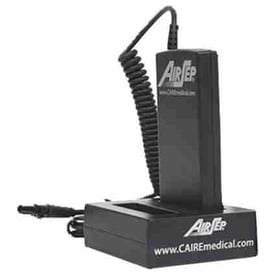
Battery life seems to be at the top of everyone’s list of features they want in a portable oxygen concentrator and it’s easy to see why. More battery life equates to more freedom.
While this all seems pretty straightforward when comparing concentrators, there are a couple of things you should know.
Finding the True Battery Life
The specifications the manufacturers release can be misleading at times. It’s similar to the way car manufacturers publish the estimated MPG, just not as deceiving.
The thing is, they want to position their unit as the best possible choice in every category they can. This means sometimes the manufacturers will use a pulse flow setting of 1 for their expected battery life rating. Or in other cases, they will reduce the average breaths per minute to boost battery life ratings.
Unfortunately this causes a lot of confusion and can lead to some pretty disappointing experiences, but that’s why we are letting you know about it and how to decipher their code.
Different Battery Options
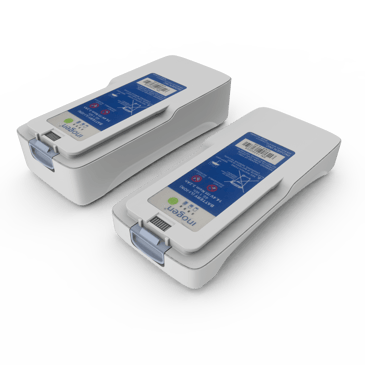
Some concentrators conveniently have two different battery options or they operate using one or two batteries, but this can be confusing when it comes to comparing battery life. For example, the Inogen One G4 specifications state the unit gets up to 6 hours of battery life, but it’s usually advertised with the battery that gets up to 3 hours.
Again, this is because the manufacturers want to position their unit as the best.
If you realize a concentrator has multiple battery options or operates using one or two batteries it’s fair to assume that the battery specifications listed are for the bigger battery option or when the concentrator is running on two batteries.
So here’s what you need to do:
- When you are comparing portable oxygen concentrators and their expected battery life times make sure you are looking at the flow rate that matches your prescription.
- Double-check to see if the concentrator you are interested in has different battery options or if it can operate using one or two batteries.
Taking these two steps will help you accurately determine which concentrator works best for you and you will know exactly what to expect when your concentrator arrives.
Size and Weight

The second most popular feature people look for in a concentrator is the size and weight of the unit. Most people want the smallest and lightest concentrator that will work for them, and some will even try to get a unit that does not work for them simply because of the size and weight of the machine.
We understand why the smaller units are so popular, but the reality is, you need to pick the unit that is going to work best for you, regardless of the size and weight.
Size Can Be Intimidating
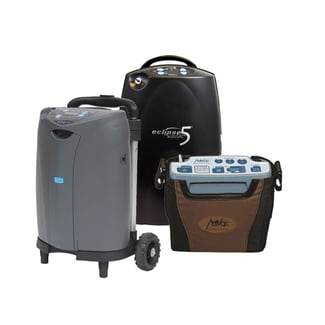
Portable oxygen concentrators come in a variety of different sizes and weights. The smallest unit weighs 1.75 pounds and the heaviest unit weighs over 20 pounds.
When you’re looking at the different concentrators it’s easy to see one of the larger units and say, “There’s no way I could ever use that.”. Once you move past the pictures you see the weight of the machine and it’s 18 pounds.
Who in their right mind can transport an 18 pound portable oxygen concentrator while battling a respiratory disease?
You might be surprised to learn this, but in a lot of situations the 18 pound concentrator requires less energy to pull behind you than the small units require when you carry them.
With that being said, it’s recommended that you get the lightest unit that will actually work for you. This will ensure you use less energy transporting your concentrator and still get your required oxygen.
Different Carrying Options
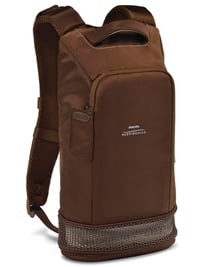
- Shoulder Strap
- Handle Strap
- Backpack
- Travel Cart
Nighttime Oxygen Delivery
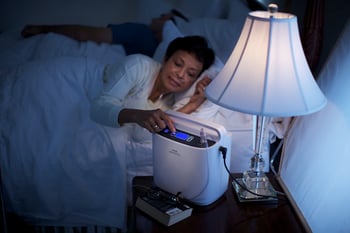
Depending on how you plan to use your concentrator, nighttime oxygen delivery can either be very important to you or not matter at all. For example, if you’re only planning on using your concentrator to get out of the house, nighttime oxygen delivery wouldn’t be a big deal. Whereas if you plan on traveling and using the concentrator 24/7, nighttime oxygen delivery is a necessity.
Every continuous flow portable oxygen concentrator is approved for nighttime oxygen delivery and a handful of pulse flow portables are approved as well.
Continuous Flow for Nighttime Oxygen Delivery
Every continuous flow portable oxygen concentrator is approved for nighttime oxygen delivery because they provide you with oxygen regardless of your breath rate. As long as your concentrator is plugged into a power source or has a charged battery installed it will supply you with your required oxygen.
Another benefit of continuous flow portable oxygen concentrators is that they are compatible with CPAP and BiPAP machines. This is crucial for those who suffer from sleep apnea.
Sleep Mode Technology
Sleep mode technology is a fairly new feature for pulse flow portable oxygen concentrators. And it seems like sleep mode technology is improving with each new model that comes out.
However, sleep mode technology does not work for everyone.
Instead of having a continuous flow of oxygen, sleep mode technology increases your concentrator’s sensitivity to detect your breath.
Because sleep mode technology does not turn your concentrator into a continuous flow machine, it will not work for you if you require a CPAP or BiPAP machine. And in some cases, if you are a mouth breather the machine might not detect your breath.
Continuous Flow vs Pulse Flow
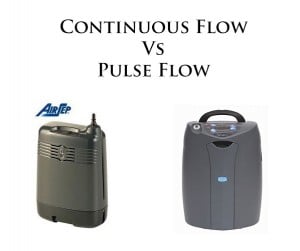
Portable oxygen concentrators have two different oxygen delivery modes; pulse flow and continuous flow. One mode isn’t better for you than the other, they are available to meet the requirements of different people.
Some people can use pulse flow during the day and continuous flow at night. Some people require a continuous flow 24/7. And others might only require oxygen when they are exercising. So it’s important that you choose the one that will work best for you.
So what is the difference between pulse flow and continuous flow?
Continuous Flow
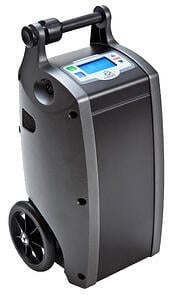
Continuous flow oxygen delivery provides you with a steady stream of oxygen, regardless of your breathing rate. If you’re concentrator is set to 2 LPM, it will provide you with 2 liters of oxygen every minute no matter what.
If you’re comparing portable oxygen concentrators to oxygen tanks, a continuous flow portable oxygen concentrator is the equivalent of an oxygen tank with a regulator on it.
Pulse Flow
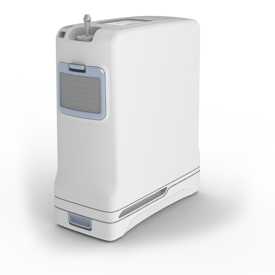
Pulse flow oxygen delivery provides you with oxygen intermittently and on-demand by reacting to your breathing pattern. Everytime you inhale, your concentrator will detect your breath and trigger a bolus dose of oxygen. Pulse flow settings do not translate to continuous flow settings. For example, a pulse flow setting of 2 does not equal 2 LPM on continuous flow.
Pulse flow works by delivering a predetermined dose of oxygen. On a pulse flow setting of 2, the average dose is 16/mL per dose. So, if you’re comparing portable oxygen concentrators to oxygen tanks, a pulse flow portable oxygen concentrator is the equivalent of an oxygen tank with a conserver on it.
Not Sure if Pulse Flow Will Work for You?
If you are new to oxygen or if you have never been tested to use a pulse flow device, don’t immediately rule them out because your prescription says you need a continuous flow. Talk with your doctor about getting tested to use pulse flow if that’s the kind of device you truly want.
Conclusion
When you are doing your research on portable oxygen concentrators there are a few things you need to keep in mind; your flow rate, what your primary use of the concentrator will be, and which features are most important to you.
At first the research can be overwhelming with information, but don’t let it stress you out. To make your hunt for a concentrator easier, download our free portable oxygen concentrator comparison cheat sheet! With the cheat sheet you will be able to compare every portable oxygen concentrator side-by-side and you will be able to see which concentrators are "Best In-Class".




